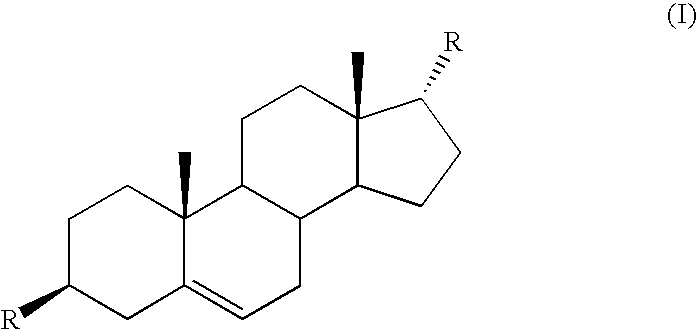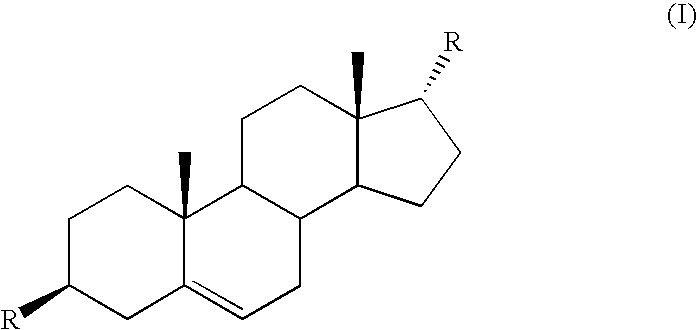Method of treatment of prostate cancer
a prostate cancer and treatment method technology, applied in the field of cancer, can solve the problems of relapse, advanced or metastasizing cases, and no cure, and achieve the effects of reducing the risk of prostate cancer, and improving the survival ra
- Summary
- Abstract
- Description
- Claims
- Application Information
AI Technical Summary
Benefits of technology
Problems solved by technology
Method used
Image
Examples
example 1
[0085]In vitro experiments have shown an apoptotic effect of αAED in a myeloid cell line and in breast cancer cell lines. It has previously been shown that effects were not dependent on any androgenic or estrogenic effects. See U.S. Pat. No. 5,912,240.
[0086]The Dunning prostate cancer cell-line, AT-1, is a completely hormone-refractory tumor. It lacks measurable quantities of receptors for androgens as well as estrogens. As a result, the clinical behavior of this tumor is not influenced by the presence or absence of sex steroids. The doubling time of the tumor is 2.5 days, which makes it one of the most slow-growing of all hormone-refractory Dunning tumors. It has a low (less than 5%) tendency for metastasis. The Dunning tumors are suitable for evaluating immunologic experiments with prostate cancer as they grow in immunocompetent animals.
[0087]The experiments described below show the effect of αAED and βAED in vivo on the Dunning AT-1 tumor. The effects of αAED and βAED on Dunning,...
experiment 1
[0090]In this experiment Dunning AT-1 tumor was passed through two Copenhagen-Fisher male rats and then transplanted in a single piece, approximately 10 mm3, which was placed subcutaneously on a third Copenhagen-Fisher male rat's dorsal side. Tumors were allowed to grow to approximately 17 mm in diameter before treatment started. Four groups of six rats each were used.
[0091]Group 1 animals received βAED in a mixture of absolute ethanol and PEG 400 1:1. βAED was given only on one occasion.
[0092]Group 2 animals received one intra-tumoral injection of 0.1 mL of complete Freund's adjuvant and βAED as above. Freund's complete adjuvant is used to potentiate immune reactivity and to trigger a T-cell response.
[0093]Group 3 animals received only complete Freund's adjuvant, 0.1 mL intra-tumorally.
[0094]Group 4 animals served as tumor-bearing controls.
experiment 2
[0095]In the second experiment, rats were treated as in experiment 1, but tumor size was not allowed to exceed 10 mm in diameter. This experiment was made to further evaluate the influence of tumor size on the outcome of treatment.
[0096]Besides studying the effect of αAED as a single drug, a sequential treatment was used to test for an increased effect of a subsequent injection of βAED. Animals were divided in four groups:
[0097]Group 1 animals received a single injection of 80 mg βAED.
[0098]Group 2 and 3 animals received a single injection of 10 mg of αAED. Animals in Group 2 were sacrificed 96 hours after receiving αAED.
[0099]Group 3 animals received a single injection of βAED, 96 hours after receiving αAED.
[0100]Group 4 animals served as tumor-bearing controls.
Results:
PUM
| Property | Measurement | Unit |
|---|---|---|
| time | aaaaa | aaaaa |
| time | aaaaa | aaaaa |
| time | aaaaa | aaaaa |
Abstract
Description
Claims
Application Information
 Login to View More
Login to View More - R&D
- Intellectual Property
- Life Sciences
- Materials
- Tech Scout
- Unparalleled Data Quality
- Higher Quality Content
- 60% Fewer Hallucinations
Browse by: Latest US Patents, China's latest patents, Technical Efficacy Thesaurus, Application Domain, Technology Topic, Popular Technical Reports.
© 2025 PatSnap. All rights reserved.Legal|Privacy policy|Modern Slavery Act Transparency Statement|Sitemap|About US| Contact US: help@patsnap.com



